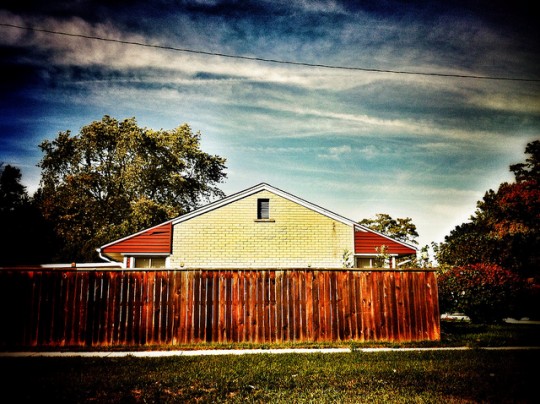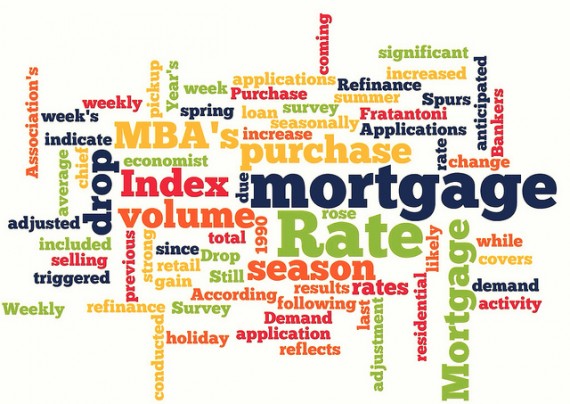According to the Mortgage Bankers Association’s Weekly Applications Survey, the average contract interest rate for 30-year fixed-rate mortgages fell last week. The drop in rates was the first following two consecutive weeks of increases and led to a 9.4 percent spike in total mortgage application demand, which includes both purchase and refinance activity. The seasonally adjusted Purchase Index, which is an indicator of future home sales, jumped 9 percent from one week earlier, while the Refinance Index rose 10 percent. The improvement puts purchase activity 6 percent higher than its level two weeks ago, though it still trails last year’s pace by 19 percent. The MBA’s weekly survey has been conducted since 1990 and covers 75 percent of all retail residential mortgage applications. More here.
Tag Archive for MBA
Mortgage Rates Rise Again In Latest Survey
According to the Mortgage Bankers Association’s Weekly Applications Survey, the average contract interest rate for 30-year fixed-rate mortgages climbed slightly last week from the week before. It was the second consecutive week of mortgage rate increases, with the average rate up for conforming loan balances, jumbo loans, and mortgages backed by the FHA. The rise in rates coincided with an 8.5 percent decline in the Market Composite Index, which measures total mortgage loan application volume. The Refinance Index fell 11 percent, while the unadjusted Purchase Index was virtually unchanged from the previous week. Michael Fratantoni, MBA’s chief economist, said though demand for purchase applications was little changed, this is the time of year when a significant pickup in purchase activity would typically begin. The MBA’s survey has been conducted weekly since 1990 and covers 75 percent of all retail residential mortgage applications. More here.
Delinquency Rate Falls To Pre-Crisis Level
The delinquency rate – which includes mortgage loans that are at least one payment past due but not loans in the process of foreclosure – dropped to its lowest level since the first quarter of 2008 at the end of last year. The improvement brought the seasonally adjusted rate down to 6.39 percent of all loans, close to the historical average of around 5 percent. The data – from the Mortgage Bankers Association’s National Delinquency Survey – also showed that the foreclosure inventory was at its lowest level since 2008 as well. Michael Frantantoni, MBA’s chief economist and senior vice president of research and industry technology, said there continues to be substantial improvement in both delinquency and foreclosure rates, with most measures now back to pre-crisis levels. The delinquency rate, at its peak in 2010, was more than 10 percent of all loans. More here.
Mortgage Rates, Purchase Demand Both Fall
According to the Mortgage Bankers Association’s Weekly Applications Survey, the average contract interest rate for 30-year fixed rate mortgages fell again last week. It was the fifth consecutive week that mortgage rates have fallen. But despite declining rates, total mortgage loan application volume decreased, dropping 2 percent from the previous week due to a 5 percent dip in the Purchase Index. The Purchase Index, which measures loan requests to buy homes and is a leading indicator of home sales, is now 13 percent below the same week one year ago. Refinance activity, on the other hand, was little changed from the week before. The Refinance Index fell 0.2 percent and the refinance share of total mortgage activity remained unchanged at 62 percent. The MBA’s weekly survey covers more than 75 percent of all U.S. retail residential mortgage applications and has been conducted weekly since 1990. More here.
Mortgage Rates, Purchase Demand Both Fall
According to the Mortgage Bankers Association’s Weekly Applications Survey, the average contract interest rate for 30-year fixed rate mortgages fell again last week. It was the fifth consecutive week that mortgage rates have fallen. But despite declining rates, total mortgage loan application volume decreased, dropping 2 percent from the previous week due to a 5 percent dip in the Purchase Index. The Purchase Index, which measures loan requests to buy homes and is a leading indicator of home sales, is now 13 percent below the same week one year ago. Refinance activity, on the other hand, was little changed from the week before. The Refinance Index fell 0.2 percent and the refinance share of total mortgage activity remained unchanged at 62 percent. The MBA’s weekly survey covers more than 75 percent of all U.S. retail residential mortgage applications and has been conducted weekly since 1990. More here.
Mortgage Rates Fall To Lowest Level Since November
According to the Mortgage Bankers Association’s Weekly Applications Survey, the average contract interest rate for 30-year fixed-rate mortgages fell last week, reaching its lowest level since November 2013. It was the second consecutive week of decreases after ending 2013 on an upward swing. The drop led to a 10 percent increase in the Refinance Index and a 4.7 percent gain in overall mortgage loan application volume. The refinance share of total mortgage activity was at its highest level in a month, improving to 64 percent from 62 percent the month before. The seasonally adjusted Purchase Index, on the other hand, decreased 4 percent from one week early and was 15 percent lower than the same week one year ago. The MBA’s survey covers 75 percent of all U.S. retail residential mortgage applications and has been conducted weekly since 1990. More here.
Mortgage Rate Drop Spurs Demand
According to the Mortgage Bankers Association’s Weekly Applications Survey, total mortgage loan application volume increased 11.9 percent last week due to a significant drop in the average mortgage rate. The Refinance Index was up 11 percent and the seasonally adjusted Purchase Index rose 12 percent. The previous week’s results included an adjustment for the New Year’s. Michael Fratantoni, MBA’s chief economist, said the drop in rates triggered a pickup in refinance volume, while the change in purchase activity most likely reflects an increase following the holiday season. Still, the gain in purchase demand was more than anticipated and may indicate a strong selling season this coming spring and summer. The MBA’s survey covers more than 75 percent of all U.S. retail residential mortgage applications and has been conducted weekly since 1990. More here.







